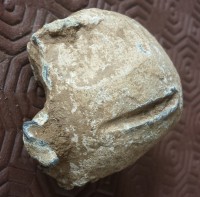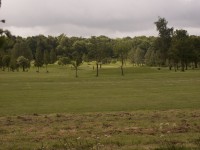A lead ball discovered on farmland that is part of the English Heritage-registered historic site of the Battle of Northampton is believed to be the oldest known surviving cannonball in England, fired at the War of the Roses battle on July 10th, 1460. The ball was first discovered near Eagle Drive, Northampton, some years ago by Stuart Allwork, the late owner of the farm, but was thought to have been lost. Mr. Allwork died in 2013; last year the cannonball was rediscovered in his house. Since then, the projectile has been analyzed in detail by Dr. Glenn Foard, the battlefield archaeologist who led the successful search for the true location of the Battle of Bosworth.
 Lead shot is disproportionately valuable to historians because it doesn’t corrode as quickly as steel and iron and can therefore be subjected to forensic ballistic examination that tells its story. The ball is about three inches in diameter and bears the scars of its use in battle. It is misshapen and gouged, impact damage from at least two bounces after it was fired. It may also have hit a tree. Particles of Northampton Sand (a subterranean geological formation that was once a shallow sea) and ironstone were found inside one of the deep gouges, evidence of how deep into the field the ball was driven and that it was used in the Northampton area.
Lead shot is disproportionately valuable to historians because it doesn’t corrode as quickly as steel and iron and can therefore be subjected to forensic ballistic examination that tells its story. The ball is about three inches in diameter and bears the scars of its use in battle. It is misshapen and gouged, impact damage from at least two bounces after it was fired. It may also have hit a tree. Particles of Northampton Sand (a subterranean geological formation that was once a shallow sea) and ironstone were found inside one of the deep gouges, evidence of how deep into the field the ball was driven and that it was used in the Northampton area.
[Dr. Foard] said: “It is highly likely that the projectile was fired during the battle in 1460”.
“I have worked with all the lead and lead composite (i.e. lead balls containing a piece of iron or stone, or many fragments of stone) round shot from battlefields of the 15th and 16th centuries that have, as far as I know, been reported from any battlefields in the UK and also those from several siege sites.
“With this knowledge I can say that this lead round from Northampton is indeed a ‘cannonball’ and that it has been fired (there is distinctive firing evidence) and has impacted with stone in the ground.”
 Historical accounts of the Battle of Northampton refer to the use of artillery on the field, or more specifically, the failure of artillery. It was raining hard when the Yorkists under Richard “Kingmaker” Neville, Earl of Warwick, advanced on the forces of King Henry VI. The Lancastrians attempted to fire cannons at their opponents, but the driving rain entirely disabled the artillery. If those sources are accurate, that would mean the Eagle Drive ball was shot from a Yorkist cannon. When Neville’s troops reached the Lancastrian defenses on the left flank, the Yorkists holding the line laid down their weapons by order of their commander Lord Grey of Ruthin who had cut a deal with Neville to betray the king in return for support in a land dispute.
Historical accounts of the Battle of Northampton refer to the use of artillery on the field, or more specifically, the failure of artillery. It was raining hard when the Yorkists under Richard “Kingmaker” Neville, Earl of Warwick, advanced on the forces of King Henry VI. The Lancastrians attempted to fire cannons at their opponents, but the driving rain entirely disabled the artillery. If those sources are accurate, that would mean the Eagle Drive ball was shot from a Yorkist cannon. When Neville’s troops reached the Lancastrian defenses on the left flank, the Yorkists holding the line laid down their weapons by order of their commander Lord Grey of Ruthin who had cut a deal with Neville to betray the king in return for support in a land dispute.
The battle was over 30 minutes later, the king captured and thousands of his troops killed either by Yorkist hand or by drowning in the River Nene during their retreat. The result of this rout was the Act of Accord which made Richard, Duke of York, heir to the throne. Henry’s wife Margaret of Anjou had no intention of meekly acceding to the disinheriting of their son, so she rallied the troops and kept the war going. Richard died in battle in December of 1460, less than two months after the Act of Accord had made him Prince of Wales. His son would become King Edward IV, the first Yorkist King of England, less than three months after that in March of 1461.
The site of the Battle of Northampton was added to the English Heritage Register of Battlefields in 1995. Few artifacts from the fight have been discovered because the field is vast — 187 hectares — and hasn’t been archaeologically excavated. Just three possible lead shots have been found and the Eagle Drive cannonball is the only one to have been thoroughly studied so that its identity as a medieval cannonball could be confirmed.